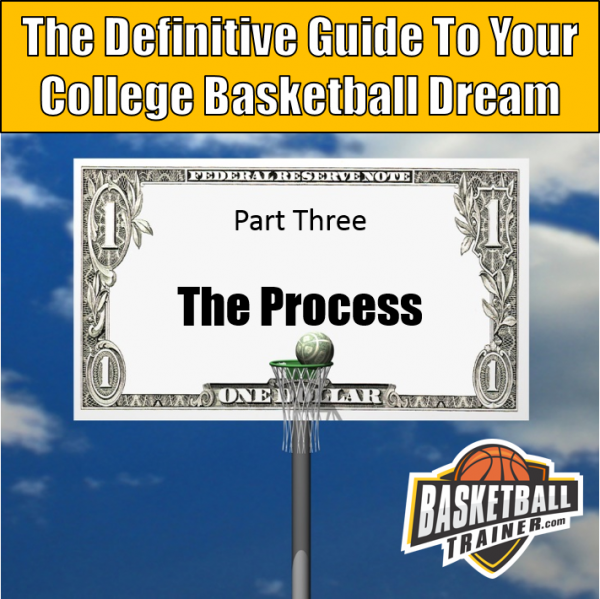Scared of Your Basketball Dream?
Don’t be.
Great rewards are proceeded by great adversity.
In order to chase the dream of playing college basketball hopeful prospects must see beyond the rare full ride (Part 1), crunch numbers in order to package themselves utilizing as many resources as possible (Part 2 Numbers Game), and then work through (Part 3 The Process) the maze that is the recruiting process with a careful diligently planned attack. Part 4 of this seven part series deals with developing the confidence, perseverance and the commitment to go “all in” to fulfill the dream.
If it is your basketball dream, go all in!
College basketball is a year round commitment. In a Varsityedge.com article Myths and Realities of College Athletics and Recruiting this level of commitment is discussed; “Playing college athletics is an unbelievable commitment in time and in dedication and will be nowhere close to your high school experience. In college you will play or practice for 3 seasons, in the fall, winter and in the spring, and be required to do lifting and running programs as well. You may also be practicing at 6AM or Midnight or twice a day depending what facilities are available at your school.”
If recruits are lucky enough to earn a spot on a college roster, programs then expect them to address their game on a regular basis. The phrase “there is no off-season” becomes reality.
Before one can live this reality, they must get there. And in order to get there, recruits will need to dedicate themselves to the game of basketball year round taking advantage of the many people and resources available to them. Most importantly they will need to be prepared for adversity, set-backs and have the courage and due diligence to see the process through and the commitment to always try to get better. Are your individual workouts in the gym and weight room both intense and scientific? Are you focused on basketball nutrition and have a quality recovery and sleep plan in place as well?
One way to get better is to seek out and use a basketball trainer. An example of a great resource for improving your game is Austin, Texas based Austin Youth Basketball. Austin Youth Basketball is growing rapidly and has impacted thousands of Austin basketball players. Look at a recent basketball trainer job description in order to better understand the criteria you should be looking for in a partner for your success.
“The BasketballTrainer.com team is comprised of former college & pro players and coaches focused on the needs of American youth basketball players. We believe that the basketball culture of America often has it’s heart in the right place but that we [coaches, trainers, parents] have strayed from teaching and sharing the foundations of the game that help kids to excel on and off the court.” According to founder Austin Youth Basketball and BasketballTrainer.com Founder Chris Corbett, who has over 20 years of experience in basketball training, “90% of our focus here is on year round personalized basketball skills training.” College basketball dreams require an edge in working harder AND smarter. A qualified basketball trainer can help. Click here to find a qualified basketball trainer.
Players have a hard time making a college roster if they don’t work on their game year round and seek out individual attention to improve upon and hone their skills. On the flip side, players now a days all too easily pick up bad habits while shelling out big bucks on AAU, travel teams and showcase leagues. If they aren’t spending too much money playing organized ball because they don’t have the resources, young players also fall victim to 5-vs-5 pick-up games where they are hosting up NBA threes, throwing around the back no-look passes and cherry picking on defense for run out fast breaks. Similar to education, these bad habits when practiced on a regular basis when your young, become hard to break when it counts, looking for a significant scholarship and college roster to join. Players no-longer feel that they need to work on their game and instead, work on finding the easiest way to gain the most exposure by playing as many games as possible. In a July 28, 2011 blog posted by Marcus Bray, a club coach states that “Putting in the work to improve as a basketball player has become ‘not sexy enough’ for most young players. What I mean by this is that players today would rather travel to tournaments and play basketball games than put in the time and effort to improve their basketball skills.”[3]
The problem is that if a prospect is lucky enough to get on a college roster, College coaches actually PREFER and require that their players to go through individual workouts.
Visiting the Basketballhq.com site, we see from Mercer University (Atlanta, GA), that college programs stress the need and value of the individual work. In regards to their Individual Basketball Skill Development Philosophy, Assistant Coach Doug Esleeck explains in a basketballhq.com entry that “One of the most important aspects of our program under [Head] Coach Hoffman at Mercer University has been individual development. We work our guys hard day in and day out on the basketball fundamentals of the game. This develops our players’ skills, improves their confidence, and instills a work ethic that has led to a culture in which players value individual development. This, in turn, produces players who work on their game on their own, and as these players see success it has encouraged our entire team to spend time in the gym outside of practice.”
College Coaches could care less if you play 5 vs. 5 outside of the season. They’re more concerned that you are getting enough reps on your shot, ball handling, and position specific stuff (post or perimeter) as well as addressing your strength and conditioning then how you did in the local organized summer league game. They want their players to address their weaknesses and build off their current strengths. This isn’t going to happen in a two hour league game. Players simply won’t get enough touches with the ball and when they do, they won’t be doing program specific stuff. From a college program perspective, it is more efficient to have small groups of no more than four players, working for no longer than an hour on the court and then another hour on their body in an effort to get bigger, stronger and faster to prepare for a game which now demands so much of your body and mind.
You are your chief sales and marketing officer
While AAU, showcases, recruiting agencies, coaches, parents and basketball trainers can help you “sell” yourself to college recruiters, you are ultimately the chief sales and marketing officer for your future as a college player. Do not wait to be chosen. Choose yourself! Putting aside self doubt and overcoming your fears are critical at this phase.
One unique option out there that strives to help high school age kids navigate through the college maze is The Sport Source.com – they are not a recruiting agency but instead a guide for recruits and parents. As put in simple and direct terms, “Our goal has remained the same – to ensure all kids who can make it in college make it to college. Making a smooth transition from high school to college is what we are all about. Though we can’t guarantee everyone will receive a full athletic scholarship, we can promise that if you are honest with your abilities, you will find the right opportunity to make your dream a reality.” So much time, effort and organization goes into finding the perfect fit for players dreaming to play college ball. The Sport Source provides direction, advising, options and will give kids choices from a network of 5800 colleges in the US and Canada and over 30,000 Coaches looking for the diamond in the rough.
As discussed in Part 2: The Numbers Game, recruits that display not only athletics but academic ability are attractive to college recruiters. Prospects must continue to work on their grades, take College Prep courses, focus on SAT-ACT tests, write strong essays. NCAA sports are an incredible experience but as the famous commercial states, “There are more than 400,000 NCAA student-athletes, and most of them go pro in something other than sports.”
Stay tuned for more info on your marketing plan and communication with colleges!
Expanding your contacts into colleges and coaches
Resources such as basketballtrainer.com, BasketballHQ.com, and The Sport Source will help you become more attractive to college coaches and once you have built your body and organized a way to present yourself go forth and build an “A” list of where do you want to be. Remember, you want exposure, not to get exposed. Work on your skills, build your team up, and then worry about marketing.
Careful planning, utilizing the RIGHT resources and then carefully weighing all your options will help you to get through THE PROCESS on top!


 In an effort to gain more exposure prospects will often attend showcase events run by a variety of different organizations in the summer, fall and spring. Showcase events also occur during the high school season when organizers look to schedule multiple games pitting non-conference opponents against each other in a day-long, weekend or a holiday setting drawing recruiters while they look to cash in on sponsors, fans, concessions and merchandise. Showcases are very often attended by college, prep and junior college coaches from all levels and give kids a chance to really make a great impression. However, prospects can also often leave these events overwhelmed, intimidated and under the radar with such an influx of talent all at one location in a condensed time setting. Various factors including politicking by high school and all-star coaches as well as parents and even the showcase promoters cause a high percentage of quality prospects to miss out. These events have become platforms for grassroots organizers to promote their product while putting on a great show which showcases individualized play.
In an effort to gain more exposure prospects will often attend showcase events run by a variety of different organizations in the summer, fall and spring. Showcase events also occur during the high school season when organizers look to schedule multiple games pitting non-conference opponents against each other in a day-long, weekend or a holiday setting drawing recruiters while they look to cash in on sponsors, fans, concessions and merchandise. Showcases are very often attended by college, prep and junior college coaches from all levels and give kids a chance to really make a great impression. However, prospects can also often leave these events overwhelmed, intimidated and under the radar with such an influx of talent all at one location in a condensed time setting. Various factors including politicking by high school and all-star coaches as well as parents and even the showcase promoters cause a high percentage of quality prospects to miss out. These events have become platforms for grassroots organizers to promote their product while putting on a great show which showcases individualized play.  New York City is known as a breeding ground for point guards. Nate Archibald (Bronx), Mark Jackson (Brooklyn), Earl “The Pearl” Washington (Brooklyn), Bob Cousy (Cambria Heights), Sebastian Telfair (Brooklyn) and Kenny Anderson (Queens) to name just a few have given the world of basketball some of the best pure point guards ever seen.[2] On the flip side of the city life, there are the Larry Bird-prospects that rise to the NBA from rural small towns in underpopulated remote areas. The
New York City is known as a breeding ground for point guards. Nate Archibald (Bronx), Mark Jackson (Brooklyn), Earl “The Pearl” Washington (Brooklyn), Bob Cousy (Cambria Heights), Sebastian Telfair (Brooklyn) and Kenny Anderson (Queens) to name just a few have given the world of basketball some of the best pure point guards ever seen.[2] On the flip side of the city life, there are the Larry Bird-prospects that rise to the NBA from rural small towns in underpopulated remote areas. The 
 The NCAA also require SAT or ACT minimum “sliding scale” scores for admissions. The sliding scale is in place to give students flexibility in regards to their low GPA or test scores.[10] To qualify to play intercollegiate athletics at the NAIA level, students must meet two out of the following three requirements; a minimum of 18 on the ACT or 860 on the SAT (Critical Reading and Match only), earn an overall high school GPA of 2.0 on a 4.0 scale and/or graduate in the top 50% of their graduating class.[11] The NAIA offers the two out of three instead of the NCAA sliding scale test score method but both have the same purpose, give lower academic students some flexibility to become eligible. Passing through NCAA and/or NAIA Eligibility Center does not guarantee admission into a given school. The final decision for acceptance to a school and the completion of The Process lies in the hands of the admissions department at each respective institution.
The NCAA also require SAT or ACT minimum “sliding scale” scores for admissions. The sliding scale is in place to give students flexibility in regards to their low GPA or test scores.[10] To qualify to play intercollegiate athletics at the NAIA level, students must meet two out of the following three requirements; a minimum of 18 on the ACT or 860 on the SAT (Critical Reading and Match only), earn an overall high school GPA of 2.0 on a 4.0 scale and/or graduate in the top 50% of their graduating class.[11] The NAIA offers the two out of three instead of the NCAA sliding scale test score method but both have the same purpose, give lower academic students some flexibility to become eligible. Passing through NCAA and/or NAIA Eligibility Center does not guarantee admission into a given school. The final decision for acceptance to a school and the completion of The Process lies in the hands of the admissions department at each respective institution. A typical admissions checklist for a college or university will include an application ($40 fee), official high school transcripts, letter of recommendation and a brief essay. Admissions departments will also encourage a campus visit and once they have the prospective student touring their grounds, they will conduct an interview. More and more schools have moved to the on-line approach of recruiting which enables them to attract and filter through large numbers of recruits without physically having them on-campus. While college coaches are targeting student-athletes for their teams as early as middle schools, the admissions process typically begins junior year in high school when students, guidance counselors along with parents and or guardians will target schools and map out some possible campus visits. Some highly regarded academic high schools have students begin this process their sophomore year but generally some prep work and “feeling out” is done junior year and The Process really takes flight senior year. Students will prepare essays (1-2 pages), gather letters of recommendation (usually 1 or 2 from a teach, guidance counselor or other school official) and official transcripts (complete with grades, class rank and test scores) while deciding which colleges they would like to apply to and figure out if they want to go for early or general admissions to the chosen institution(s).[12] Once application files are complete, schools make a decision and put the ball in the court of the recruit.
A typical admissions checklist for a college or university will include an application ($40 fee), official high school transcripts, letter of recommendation and a brief essay. Admissions departments will also encourage a campus visit and once they have the prospective student touring their grounds, they will conduct an interview. More and more schools have moved to the on-line approach of recruiting which enables them to attract and filter through large numbers of recruits without physically having them on-campus. While college coaches are targeting student-athletes for their teams as early as middle schools, the admissions process typically begins junior year in high school when students, guidance counselors along with parents and or guardians will target schools and map out some possible campus visits. Some highly regarded academic high schools have students begin this process their sophomore year but generally some prep work and “feeling out” is done junior year and The Process really takes flight senior year. Students will prepare essays (1-2 pages), gather letters of recommendation (usually 1 or 2 from a teach, guidance counselor or other school official) and official transcripts (complete with grades, class rank and test scores) while deciding which colleges they would like to apply to and figure out if they want to go for early or general admissions to the chosen institution(s).[12] Once application files are complete, schools make a decision and put the ball in the court of the recruit. Financial planning and financial aid are often a deal breaker in the recruits’ decision to where they go to school. While the hope is that students will be able to afford college with a full-ride athletic scholarship (Part 1) or some sort of family trust, nest egg or a big dip into savings, the reality is that two thirds[13] of all students take advantage of academic merit scholarships, athletic scholarships and/or FAFSA as discussed in Part 2 (link or even excerpt here). Students can apply for FAFSA beginning on January 1 of their senior year in high school. Early application is encouraged as much of the funds are awarded first come, first serve once the need is determined to be equal. The Process for the ‘average’
Financial planning and financial aid are often a deal breaker in the recruits’ decision to where they go to school. While the hope is that students will be able to afford college with a full-ride athletic scholarship (Part 1) or some sort of family trust, nest egg or a big dip into savings, the reality is that two thirds[13] of all students take advantage of academic merit scholarships, athletic scholarships and/or FAFSA as discussed in Part 2 (link or even excerpt here). Students can apply for FAFSA beginning on January 1 of their senior year in high school. Early application is encouraged as much of the funds are awarded first come, first serve once the need is determined to be equal. The Process for the ‘average’  Put quite simply, the more a coach wants a player, the more attention he or she is going to get during The Process. However, recruits should never stop trying to prove themselves and should not settle for a team because it is local, or their sibling or friend is there or because they are being pushed there by a community, parents, high school coach or some other outside influence. If you are looking to get a start in narrowing down college choices that might be a fit for you, then I recommend you use a tool developed by a company I am involved with. The Sport Source has a tool that is free for 24 hours use that permits you to input some of your criteria and also qualifications and then helps create a personalized database of which schools could be a fit for you.
Put quite simply, the more a coach wants a player, the more attention he or she is going to get during The Process. However, recruits should never stop trying to prove themselves and should not settle for a team because it is local, or their sibling or friend is there or because they are being pushed there by a community, parents, high school coach or some other outside influence. If you are looking to get a start in narrowing down college choices that might be a fit for you, then I recommend you use a tool developed by a company I am involved with. The Sport Source has a tool that is free for 24 hours use that permits you to input some of your criteria and also qualifications and then helps create a personalized database of which schools could be a fit for you. 


